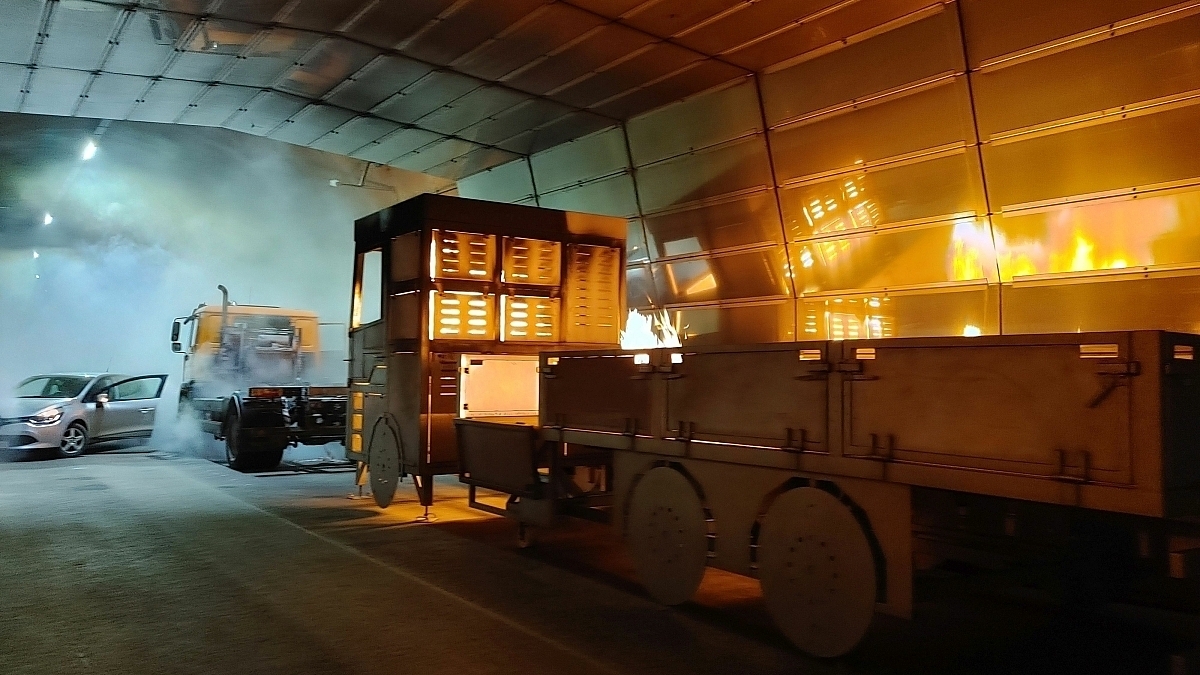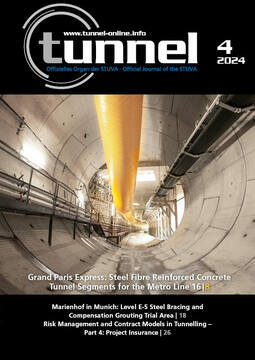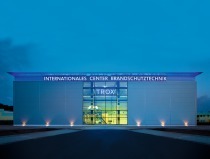Analysis of Reaction and Escape Behaviour in Road Tunnels Under Consideration of Group Effects
Road tunnels in Europe provide a high level of safety. A substantial amount is invested in technical equipment and fire protection measures. However, if a major fire does occur in exceptional cases, smoke extraction and fire protection systems as well as properly signposted escape routes protect the lives of the affected road users. Of course, the ‘correct’ behaviour of people is also important. But how do they actually behave in such an extreme event?
Regulations such as RE-ING [1], the EU Directive [3] and EABT [2] have so far been based on assumptions about average reaction times and walking speeds, as little research has been carried out into individual human behaviour in the event of a tunnel fire. There is hardly any knowledge of the group dynamic effects occurring among the people affected in a shared hazardous situation. This is precisely what the STUVA is trying to find out on behalf of the German Federal Ministry for Digital and Transport (BMDV) and the Federal Highway Research Institute (BASt) together with research partners CSS from the University of Freiburg and the University of Leoben in Austria. To this end, a scenario was set up in a tunnel with a simulated truck fire and a lot of (harmless) smoke (Fig. 1).
 1 | Rear view of the accident scene: Dummy truck with simulated fire and a harmless but threateningly dense “wall of smoke” from smoke machines
1 | Rear view of the accident scene: Dummy truck with simulated fire and a harmless but threateningly dense “wall of smoke” from smoke machines
Credit/Quelle: STUVA
The shock for the volunteer test participants comes unexpectedly: a few hundred metres after entering the tunnel, the brake lights of the vehicles in front flare up (Fig. 2). A wall of smoke appears in front of the convoy. Dimly visible behind the smoke: a burning truck and a crashed car blocking the road!
 2 | The first vehicles reach the scene of the accident (still image from video footage)
2 | The first vehicles reach the scene of the accident (still image from video footage)
Credit/Quelle: STUVA
The research team closely monitors the reactions of the 13 people in their eight cars via the numerous hidden video cameras. Fortunately, this is just a harmless experiment with one of five groups of test subjects in the Austrian ‘”Zentrum am Berg‘” at the Montanuniversität Leoben. This underground facility consists of a twin-tube road tunnel and two parallel railway tunnels as well as a test gallery. Usually, firefighters are trained here. In the research project “Analysis of reaction and escape behaviour in road tunnels taking into account group effects FE 15.0703/2022/ERB” [4], the intention is to generate the most realistic possible scenario of the reaction and escape behaviour of groups of people in an accident involving a vehicle fire in road tunnels. All of the test subjects volunteered to drive through different tunnel configurations and then evaluate them. They did not know beforehand that they would end up in such an extreme situation, as this would have falsified their reactions and therefore the results of the study.
“We want the test results to be as realistic as possible,” explains Head of Research Dipl.-Ing. Frank Leismann from the STUVA. ‘That‘s why we attached great importance to getting as accurate a picture as possible of the actual driving population when selecting the volunteers.’ People with different levels of driving experience and previous knowledge were deliberately selected. The occupancy rate of the vehicles also corresponded as closely as possible to that of normal road traffic: there were some single drivers and some cars were occupied by families. Of course, the necessary safety measures were also extensive; pregnant women and wheelchair users, for example, were excluded from participation from the outset. In addition, the test could have been stopped immediately at any time if people had endangered themselves or others through their own behaviour. For safety reasons, several employees were hidden around the prepared accident site and could have intervened if necessary.
Apparently, all of the test subjects were convinced that it was a real fire incident and behaved as they would have done in an emergency. Some stayed in their vehicle for a long time and ignored the loudspeaker announcements urging them to flee. Others left the vehicle but locked it and took the ignition key with them. Some initially ran away from their vehicle, but then returned. Some drivers even turned their vehicle around and exited the tunnel.
 3 | Most of the vehicle passengers have left their cars and are fleeing towards the emergency exit (still image from video footage)
3 | Most of the vehicle passengers have left their cars and are fleeing towards the emergency exit (still image from video footage)
Credit/Quelle: STUVA
 4| Group effects like this are the focus of the research project: The picture shows people in (perceived) danger coordinating their behaviour (still image from video footage)
4| Group effects like this are the focus of the research project: The picture shows people in (perceived) danger coordinating their behaviour (still image from video footage)
Credit/Quelle: STUVA
It was particularly interesting for the researchers to observe how road users influenced each other. For example, one test participant asked the occupants of another car to finally get out of their car and follow him to the emergency exit (Fig. 3). The researchers are specifically interested in analysing these so-called group effects. It is already known from previous studies that people try to make a collective decision to escape, and that in extreme situations there is a certain group dynamic that can have both positive and negative effects on the escape of everyone in the tunnel (Fig. 4). However, these group effects have not yet been sufficiently predictable, nor have they been adequately quantified to be part of standard safety assessment procedures. Inevitably, such group dynamic effects have been neglected as input values for quantitative risk analysis when determining reaction and escape velocities.
Such sociological and psychological effects can only be determined by realistic experiments, not by theoretical approaches. In real-life events in tunnels, the safety of the road users involved has absolute priority, leaving no room for scientific analysis For legal reasons, even video recordings of real events are hardly accessible. Furthermore, due to the different circumstances that randomly occur in each individual case, there is no comparability with other events, so that only a limited evaluation of the group dynamics would be possible in retrospect.
On the one hand, the evaluation of the experiment aims at sociological components in order to understand the observed behaviour as precisely as possible. On the other hand, relevant escape parameters (in particular reaction and escape times) will be determined from an engineering point of view. The data obtained will then be used to assess the need for further updating of the road tunnel safety assessment procedure and the corresponding risk analysis assessment procedure. The research project will also use the results to assess whether the existing regulations are adequate or need to be adapted. It will also identify aspects that require research, development or adaptation in the short and medium term. Particular attention will be paid to areas where information and training on correct behaviour in tunnels is needed. It will take several months to analyse the large amount of video footage and interviews conducted with the test subjects after the trial. Initial results were presented at the 10th BASt Tunnel Symposium on 5 November 2024 in Bergisch Gladbach (Germany).
Tips on what to do in the event of a fire in a tunnel or other emergency situations are available from the Federal Highway Authority as part of the #MehrAchtung campaign initiated by the Federal Ministry of Digital and Transport at www.mehrachtung.de/stau-unfall-feuer-im-tunnel (in German only).






